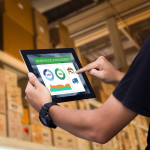3 Tips for Creating a Branded Supply Chain to Boost Your Business
This is a guest post by Keith Coppersmith.
Even though your brand and your supply chain seem like two completely unrelated aspects of your business, they are in fact two inextricable parts of the same whole. When paired, they create a phenomenon the marketing world calls the branded supply chain.
It might sound like a complex concept at first glance, but the idea behind it is quite simple. The way you manage your supply chain will have a significant impact on your brand, while the way you brand your business will have an impact on your supply chain.
Ultimately, the idea is to maximize both through this symbiotic concept.
Here’s what you need to know.
Inspire Customer Loyalty
Customer loyalty is the driving force behind long-term success in today’s competitive business world. Stats say that landing a new customer can cost up to five times more than retaining an existing one. Precisely because of that, building a customer-centric marketing strategy should be your priority. Your goal is to encourage customer loyalty with each and every one of your business processes, including branding, marketing, and supply chain management.
Building an innovative, transparent, and cutting-edge branding campaign doesn’t just mean telling a story to your customers. On the contrary, you need to ensure that your supply chain delivers on these promises.
Listen to your customers in order to learn more about their needs, problems, and frustrations.
- Encourage your customers to leave reviews and comments on social networks.
- Use social media monitoring tools to set the keywords related to your supply chain and track their mentions on social.
- Send online surveys via email or SMS.
- Schedule in-person meetings and phone calls with your major customers.
Be it positive or negative, your customers’ comments and reviews will help you understand what the most common issues related to your supply chain are. Most importantly, they let you get to know your target audience and build stronger relationships with them.
Intel’s ‘Just Say Yes’ campaign proves that. They noticed that most of their customers are dissatisfied with the speed and quality of their processes. As the maintenance of their supply chain is critical for their survival in the IT sphere, they combined the data from data analytics with customer feedback to give their supply chain a notable boost. They addressed the following aspects of their supply chain:
- Providing faster order to delivery
- Shortening lead times
- Minimizing errors in demand forecasting
- Reducing inventory levels
- Responding to customers faster
Your goal is to build a highly user-centric supply chain that gives a customer exactly what they want when they want it. Without bringing true value to your customers, all investments in branding and marketing strategies would be in vain.
Increase the Transparency of Your Branded Supply Chain
Speaking of brand values, one of the most important ones is transparency. While it might be a buzzword frequently thrown around in business meetings and via run-of-the-mill marketing campaigns, it’s important to know that transparency does carry a lot of weight in the eyes of the consumer. For example, did you know that 9 out of 10 customers will ditch a business that lacks transparency?
You simply need to earn the status of a transparent brand instead of trying to persuade the public that you are deserving of the moniker. Just like Buffer emphasizes, transparency is something you choose to live by. And, implementing it with your supply chain may be a great starting point for you:
- Align transparency with marketing to make your brand more relatable.
Your customers will want to know where your materials come from and where your products are made. Chopard, a Swiss manufacturer of luxury jewelry, announced their commitment to the Fairmined schemes. Namely, their goal is to prove that their jewelry is made of gold that is responsibly mined and provide the story of its origin. This will have emotional benefits and have a positive impact on each purchase.
- Demonstrate your brand’s social responsibility.
Your customers want to know that your brand does not exploit workers, especially if you’re in the fashion industry. Just remember Zara not paying their factory workers in Turkey. Precisely because of that, popular and affordable brands like H&M brand themselves as an ethical option for price-conscious shoppers.
- Appeal to modern customers by emphasizing you’re serving the environmental cause.
Before buying your products, people will want to know that you’re not damaging the environment. They want to know that you are righteous and that all of your processes serve the environmental cause. With that in mind, be sure to stand for environmentalism in your branding as well as your supply chain strategy.
This is exactly what the Campbell Soup Company does. They’ve launched a waste reduction campaign that helped them save $4.5 million by minifying packaging sizes. Moreover, what helps them stand out from their competitors is also the fact that their plants are powered by waste from their products.
- Encourage customer-stamped transparency.
Your consumers trust online reviews more than your branded content. That’s why you should publish user-generated content, customer reviews (both positive and negative), and customer testimonials to gain people’s trust.
Ensuring the Long-Term Growth of Your Brand
When branding your supply chain, you need to keep in mind your business growth. Your goal is to create a solid brand strategy early on – branding strategy that will future-proof your business in the competitive market by emphasizing its unique culture and values.
By branding your supply chain, your goal is to become a ‘mission brand’ over time. In a sea of uniformity and companies devoid of soul or substance, you need to stand tall as the brand everyone will know and love. To that end, you need to be relatable, approachable, honest, and engaging. Once you have combined brand values with supply chain management, you will become a household name, and a brand everyone turns to first.
One such example is an organic baby food company, Ella’s Kitchen. They’ve clearly defined their brand mission, highlighting that their priority is improving children’s lives through developing healthy relationships with food. Following the above mentioned rules of transparency in branding, all products are certified by UK Organic Farmers and Growers. They also publish regular social and environmental impact reports, where they emphasize that their main goal is making 100% of their product packaging recyclable and eliminating palm oil from the supply chain.
Remember, as the number of supply chain businesses in your niche grows, customers will choose ones they trust. They will decide to buy from brands that are making the right decisions for them. Just like with the Ella’s Kitchen example, this should be your main goal when branding your supply chain.
Final Thoughts
The brand and the supply chain are not two unrelated entities. Rather, they are two parts of the same whole that ensure the long-term growth of a company. By creating a branded supply chain, you will deliver on your brand promises and future-proof your business for years to come.
Is there anything you would like to add? We’re listening.
This was a guest post by Keith Coppersmith.
Author Bio
Keith Coppersmith is a business and marketing expert who has experienced both the rise and fall of many businesses. As a regular contributor at BizzmarkBlog, he enjoys writing and providing insight of the marketing industry based on both practice and theory.





very nice tips thanks for sharing your knowledge.
Woo Nice blog about how Branded Supply Chain to Boost Your Business. Thank for sharing
Great article! Such a great ideas and insights from the experts. Person branding is important in any business. By building your personal brand, you are building your reputation.People, especially our modern audience, want to do business with other people, not companies. Part of the branding process is becoming known for something. People remember you through your actions, your expertise, and the emotional connections that you make. Ready to chat about how we can utilise our to get you noticed. Thanks for sharing this article!